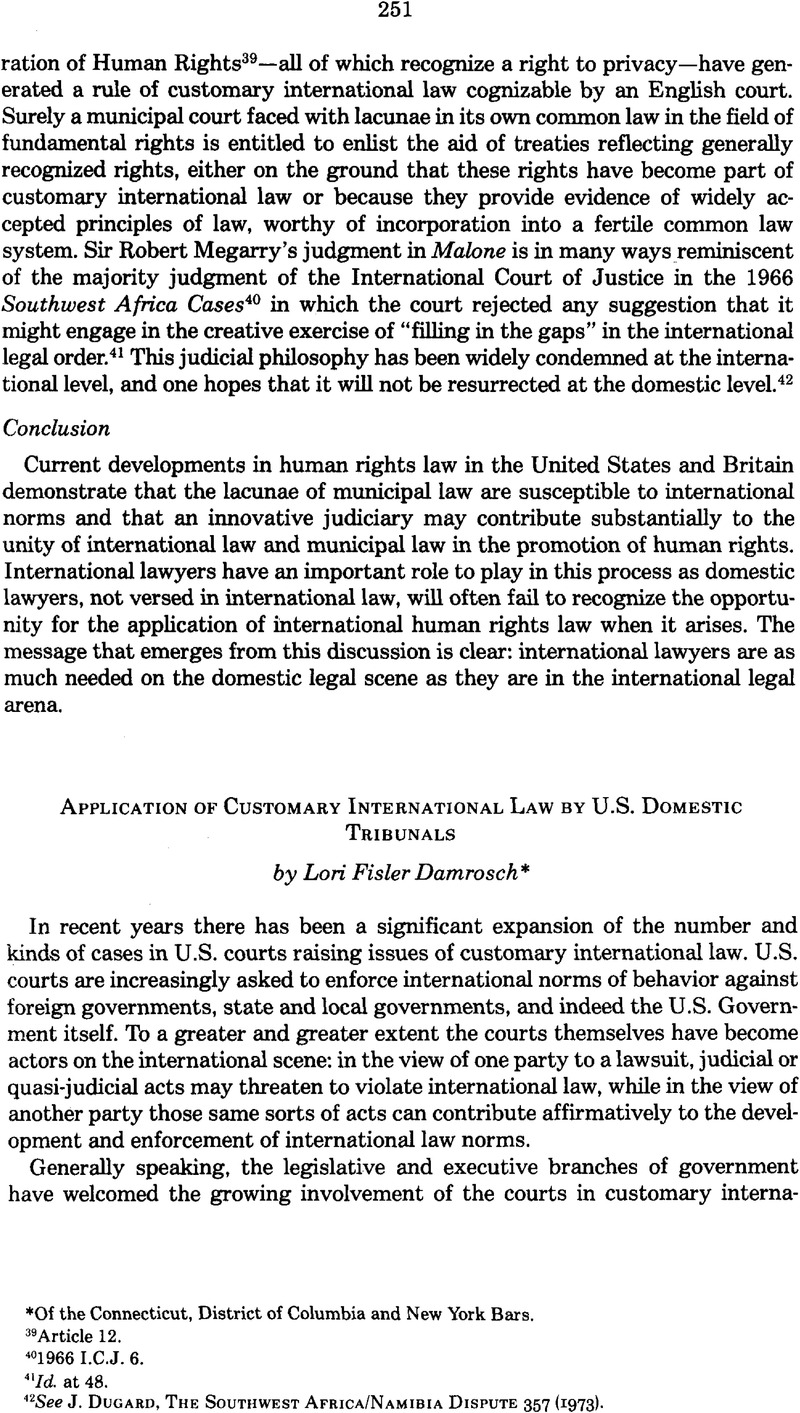No CrossRef data available.
Published online by Cambridge University Press: 28 February 2017

1 The Foreign Sovereign Immunities Act of 1976 gives a mandate to the courts to decide certain customary international law issues that had previously been left to the executive branch. See 28 U.S.C. §§1602, 1605 (a) (3), 1610 (a) (3) (1976). For other recent indications of support from the legislative and executive branches for judicial involvement in customary international law issues, see, e.g.,Statement of Senator Mathias introducing S. 1434 (the “International Rule of Law Act“), 127 Cong. Rec. S. 7120-21 (97th Cong., 1st Sess., June 25,1981); Memorandum for the United States as Amicus Curiae in Filartiga v. Pena- Irala, 630 F.2d 876 (2d Cir.), reprinted at 19 ILM 585 (1980); cf. Letter of Monroe Leigh, Legal Adviser, reprinted as Appendix 1 to Opinion of the Court in Alfred Dunhill of London, Inc. v. Republic of Cuba, 425 U.S. 682, 706-11 (1976).
2 In Galanis v. Pallanck, 568 F.2d 234, 239 (2d Cir. 1977), the court characterized the Department's statement as both “inconclusive” and “conclusory,” and cited an earlier extradition case, Greci v. Birkners, 527 F.2d 956, 960 (1st Cir. 1976), in which the views of the Department had been described as “contrary to both the plain language of the treaty and the available history.“
3 See, e.g., Avagliano v. Sumitomo Shoji American, Inc., 638 F.2d (552) (2d Cir.), cert, granted, 102 S.Ct. 501 (1981). The case was reversed June 15, 1982, id. at 2374, after Ms. Damrosch delivered her remarks.
4 Spiess v. C. Itoh & Co. (America) Inc., 643 F.2d 353, 372 (5th Cir. 1981) (Reavley, J., dissenting).
5 Id.
6 Id. at 358 n.3 (majority opinion), 372 (dissent).
7 See Spiess v. C. Itoh & Co., supra note 4; Avigliano v. Sumitomo, supra note 3.
8 Avigliano v. Sumitomo, supra note 3.
9 The problem of classified source material came up in the Iranian claims and assets litigation between November 1979 and January 1981, when the Department was hampered in taking any positions on the merits because of the continuing detention of American hostages in Iran and the pendency during part of that period of highly sensitive negotiations for their release. Some judges were willing to accept submissions in camera or under seal, see, e.g., New England Merchants Nat'l Bank v. Iran Power Gen. & Transmission Co., 502 F.Supp. 120, 133-34 (S.D.N.Y. 1980), remanded, 646 F.2d 779 (2d Cir. 1981), but others either were reluctant or refused outright. See IRANIAN ASSETS LITIGATION REPORTER, 1617-18 (Oct. 17, 1980).
10 Filartiga v. Pena-Irala, 630 F.2d 876 (2nd Cir. 1980). The government's amicus brief, on which the court drew heavily, is reprinted at 19 ILM 585 (1980).
11 Cf. Banco National de Cuba v. Sabbatino, 376 U.S. 398, 432-33 (1964).
12 See, e.g., Vienna Convention on Diplomatic Relations, 23 U.S.T. 3227, T.I.A.S. No. 7502, 500 U.N.T.S. 95; Vienna Convention on Consular Relations, 21 U.S.T. 77, T.I.A.S. No. 6820, 596 U.N.T.S. 261; Vienna Convention on the Law of Treaties, reprinted at 63 AJIL 875 (1969), 8 ILM 679 (1969).
13 See, e.g., Treaty of Amity, Economic Relations, and Consular Rights with Iran, 8 U.S.T. 899, T.I.A.S. No. 3853, 284 U.N.T.S. 93.
14 U.S. Const, art. VI. RESTATEMENT, FOREIGN RELATIONS LAW OF THE UNITED STATES (REVISED) 131 (Tent. Draft No. 1, 1980), takes the position that customary international law enjoys the same status as treaty law for purposes of Articles III and VI of the Constitution.
15 Significantly, courts have frequently noted the absence of a Department position in cases raising important international issues. See, e.g., Fernandez v. Wilkinson, 505 F.Supp. 787, 795 n.l (D. Kan. 1980), aff'd, 654 F.2d 1382 (10th Cir. 1981). There can be many reasons for nonparticipation, such as shortage of personnel in the Office of the Legal Adviser to research and brief points of law arising in litigation between private parties, or the difficulty in obtaining interagency clearance on a statement of position. On occasion, courts have inferred (sometimes incorrectly) that Department silence indicates lack of concern over points at issue. See Communications to Courts, reprinted at 74 AJIL 665-67, 928-29 (1980).
16 See, e.g., American International Group, Inc. v. Islamic Republic of Iran, 493 F.Supp. 522 (D.D.C. 1980); New England Merchants Nat'l Bank v. Iran Power Gen. & Transmission Co., 502 F.Supp. 120 (S.D.N.Y. 1980), remanded 646 F.2d 779 (2d Cir. 1981).
17 In American International Group, supra note 16, the District Court treated the issue of nationalization without adequate compensation as an issue of both treaty law and customary international law. 493 F.Supp 524-25. In New England Merchants Nat'l Bank, supra note 16, the court decided novel questions under both the Foreign Sovereign Immunities Act and the Treaty of Amity with Iran, characterizing its own decision as “no more than that traditionally held.”